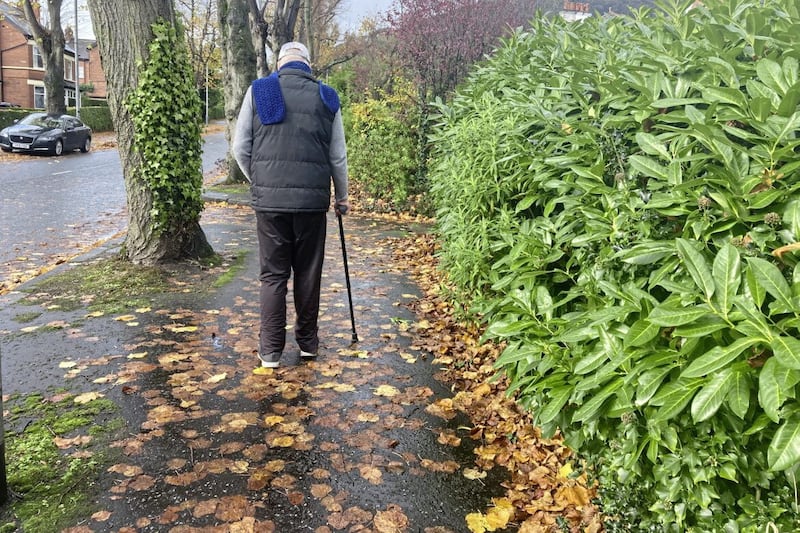IF YOU ever decided to write a family history, and I hope you do, take a leaf from Cardwell McClure’s book William Scott: A Family History.
He has uncovered a story of poverty, tragedy, war and fame; and the main character is his uncle William Scott, an artist of distinction who doesn’t have the recognition he deserves.
Although Dan Dowling, president of the Royal Ulster Academy tells me, Scott was indeed a massive talent, sadly he had no connection with the Academy which would have enhanced his local profile before his death in 1992.
He was awarded a CBE and membership to the Royal Academy in London and one of his pieces sold seven years ago for £337,000 – he was one of the most distinguished painters of his time.
Although Cardwell devotes a chapter to each member of the family, originally from Scotland, then growing up in Enniskillen, their father’s hometown, his uncle William claims most of the space and no wonder.
Research revealed a life of determination and diversity. As a boy he helped paint shop signs in his father’s workshop; he assisted in painting Orange Order banners; he attended the Kathleen Bridle art classes in the town; and in 1928 William Trimble, owner of the Impartial Reporter newspaper, launched a fund which amounted to £700 which was enough to enrol him as a student at Belfast College of Art.
Within three years he won a scholarship to the Royal Academy Schools in London where he shared a flat with Welsh poet Dylan Thomas. They must have been heady times.
IMPORTANT FIND
While gathering material, Cardwell discovered a cache of memorabilia when clearing out his mother’s house after her death. It often happens that way - older people kept documents and photographs stashed away in a memory box; today they are probably committed to a computer and eventually lost over time.
I am fortunate as, being something of a squirrel, I raided all our memory boxes over the years and have valuable history stored in a drawer with major details on a laptop – the best of both worlds.
Recently I came on a letter my grandmother wrote to her family from her cabin en route to New York on board the SS California, later sunk by bombs in the Bay of Biscay in 1943.
Tales of singing Irish songs, learning to tango, eating a cuisine new to her and the last few paragraphs of sailing into New York harbour, and seeing the Statue of Liberty loom out of the mist.
A subsequent letter describes living in an apartment high above the Queens area of New York; visiting shops and restaurants; and the delights of Long Island before the war changed everything.
Mary Edith de Winter was worshipped by her four children and they were worried about their twice widowed mother taking on this solo trip to see her cousin, so much so that before she departed they gave her a diamond ring to keep hidden in case she needed money urgently to get home.

Like Cardwell, I have a treasury to work through, but unlike me he has compiled his story and published a fascinating story of a large family, featuring his artistic uncle William Scott.
Cardwell was named after this grandmother, Agnes Cardwell, and was born in her hotel, Scotts, on Ennisklillen’s East Bridge Street.
She had 11 children, five of them died before her; in an accident, killed in action; and in 1930 Violet, her youngest daughter, and her 11th child, died at two years old. Her first husband was killed in a fire trying to rescue a mother and child caught in the building – there were many tragedies during those years.
FAMILY ARCHIVE
“Thank goodness my mother collected newspaper cuttings and photographs, she had a great closeness to William who would sit her at the table in their home and paint her. There was a lot to sort through over the last 10 years, I had to stop for a while when I was unwell, then Covid, but I’m so glad that the family have given the book their approval. I’d a phone call from a cousin in Australia who at 85 said he knew nothing about William and that he was glad he lived long enough to read the book and pass on the history to his sons.”
The author has written four books including the history of Portadown gasworks, the town’s foundry, and the Edenderry area of the town as well as the Irish Wade pottery.
His son Timothy said he’d never seen his dad read a book so he’s surprised with his fine ability to tell a story; his latest book proves that.
Cardwell told me he only met his uncle once. “My first impression was how arty he looked, well dressed and spoke well. I took him to Portadown golf club and he invited me to London, bring £1,000 and pick your painting he said. If only I had.”
David Bowie did recognise the artist’s talents. In 1993, he bought two paintings including Girl Seated At Table for a record at that time of £45,500.
“Probably my granny sitting for her talented son many years ago; after the singer's death it sold at Sotheby’s for £337,000. The record for a Scott painting at auction is £1,071,650,” he added.
Queen Elizabeth admired his work and the Irish Post Office featured one of his paintings on their 5p stamp. Less praised was his 1962 panel of huge squares and rectangles mounted in Altnagelvin Hospital foyer, according to newspaper reports it "caused controversy".
Cardwell McClure has compiled pictures, reports and first-hand accounts of his family in a fascinating book; for an accountant who apparently didn’t read books, he has succeeded in writing a memorable and detailed history.
“If I take a notion I can make it work whether it’s renovating or building houses in my retirement. But writing has given me the greatest pleasure because it’s history and that’s important, indeed when I’m gone all my writings will be left to the Public Records Office in Northern Ireland.”









